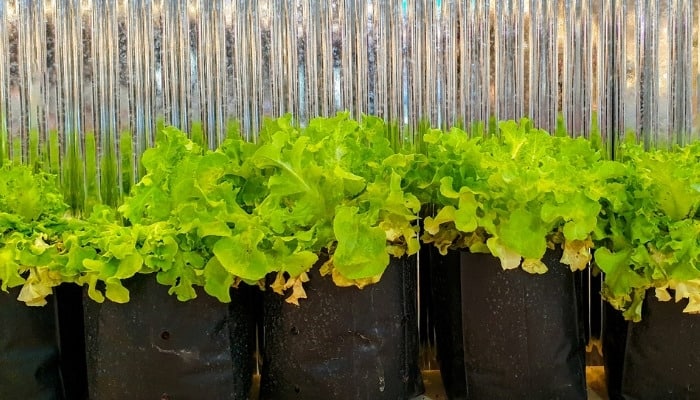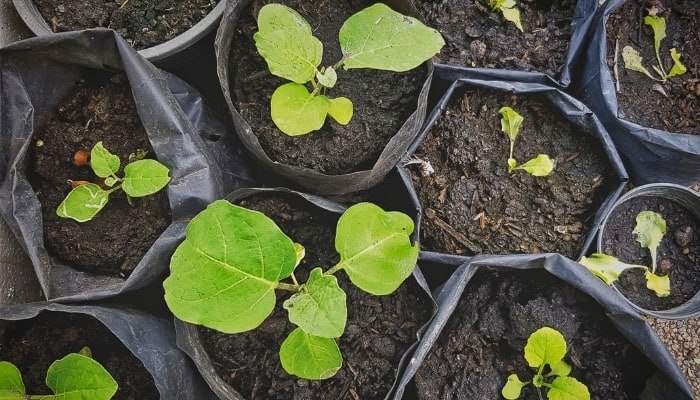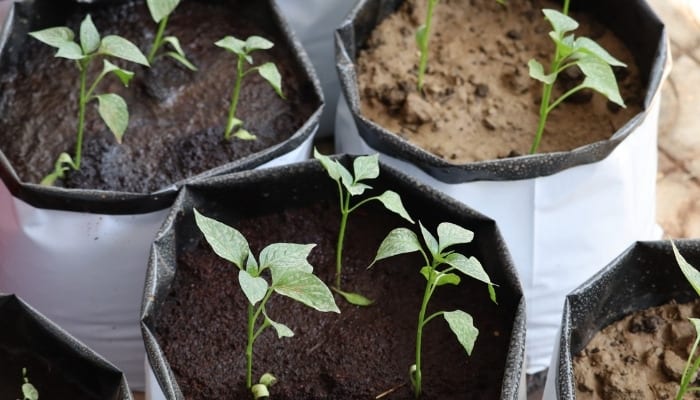Grow bags are ideal for those who are not yet ready to make a long-term commitment to a garden space, offering a great opportunity to begin growing.
Whether growing veggies, herbs, flowers, or trees, grow bags are a viable option. Grow bags come with a lot of perks.
For starters, they are cheaper than pots, they’re easy to move around thanks to the nifty carry handles they often have, and they are available in many shapes and sizes – what’s not to love, right?
What are grow bags? Grow bags are plastic or fabric bags that can be filled with a growing medium and used to grow vegetables and other plants. Grow bags are best used with plants that don’t have deep root systems, such as potatoes, salad greens, tomatoes, peppers, herbs, and similar vegetables.
If the concept of grow bag gardening has tickled your fancy and you’d like to get a bit (or a lot) more clued up before you get started, simply keep reading – we cover it all below.
Grow Bags – Basics Explained
Grow-bag gardening is a great way to grow veggies and herbs. The general rule is that if you can grow it in a container, you can grow it in a grow bag and have just as much success.
They’re an excellent solution for those without in-ground garden space or just with limited space.
Below are the few basics you need to know about getting started with grow-bag gardening.
How Do Grow Bags Work?
One of the biggest reasons so many people opt for grow bags is how they work. Let’s consider plastic containers first.
Plastic containers work great for many plants, but they’re not always the best option for your plant’s roots.
As you may know, a plant in a plastic container will have roots that grow to the edge of the container and then continue growing.
This causes a circular root growth pattern and eventually leads to the plant becoming rootbound. This is where grow bags really shine, especially when using breathable fabric bags.
When the plant’s roots reach the side of the bag, they stop growing. Why? Because when a plant’s roots contact air, they will stop growing in that particular direction.
The air circulation through the grow bag walls also leads to healthier crops because roots need air in the soil to grow.
What Are Grow Bags Made Of?
Grow bags can be made of various materials. The top choice is durable non-woven, BPA-free and AZO-free fabric, but similar products on the market are made from felt.
Some grow bags are made from plastic, but the plastic varieties are considered an inferior-quality option.
Are Fabric Grow Bags Better Than Felt Grow Bags?
Felt grow bags are very similar to fabric grow bags in that they provide good air circulation, which is excellent for the roots.
Felt can be very porous, though, so you have to be careful to ensure that you don’t let the plant’s soil inadvertently dry out.
Are Grow Bags Good?
Grow bags are good, but you need to ensure that you invest in a good quality brand and product.
The grow bag market only took off in the 1970s when it was introduced for home use.
Since then, the popularity of grow bags has simply skyrocketed and is now even used in market gardening and farming environments.
Grow Bag Benefits
There are many benefits of using grow bags over and above the fact that they are portable and convenient. Some of these benefits are listed below.
- Good temperature regulation as grow bags don’t overheat in the sun as plastic pots do.
- There is no risk of overwatering or mold and fungus growth as the grow bag doesn’t trap water/moisture.
- No chance of rootbound plants as the grow bag allows for air circulation.
Grow Bag Disadvantages
As with most things in life, there are a few disadvantages to consider. These include:
- More frequent watering is required as the fabric releases excess water immediately.
- Not as durable as pots made from other materials such as plastic and concrete.
- Not as aesthetically pleasing as plastic and concrete options.
- Not ideal for large plants.
What Can You Grow in Grow Bags?
You can grow almost anything in a grow bag as long as you have the right size grow bag! While they can be used to grow flowers, they are most often used to grow veggies and herbs.
The best plants to grow in grow bags are:
- Tomatoes
- Potatoes
- Sweet peppers
- Chili peppers
- Cucumbers
- Eggplant
- Salad greens
- Zucchini
Of course, this is not an exhaustive list as there are many, many options.

Can I Use Grow Bags for Indoor Plants?
You can use grow bags indoors, but you must select a good location with sufficient light.
As the grow bag doesn’t trap water, you will need to put a container beneath the grow bag to catch the water that passes through the bag.
Should Grow Bags Be Elevated?
Grow bags don’t have to be elevated; they can stand directly on the ground. Some gardeners use grow bags on raised garden beds, and these work well.
Can You Reuse Grow Bags?
Due to the porous nature of grow bags, they can be quite easily cleaned and re-used for years. Of course, the quality of your product will come into play.
Additionally, you must ensure that the bag isn’t left standing in water over an extended period.
How Long Do Grow Bags Last?
Most grow bags can last several years, in most instances 2 to 3 seasons.
What Size Grow Bag Do I Need?
As is the case with all containers, you will need to choose a grow bag that is suitably sized for the plants you wish to grow.
Below is a quick overview of sizing for quick reference.
What Size Grow Bag for Vegetables?
The type of vegetable you are growing will determine the size of grow bag you need. Grow bags under 2 gallons are suited to plants with a pot diameter of less than 8’ inches and no taller than 9.5 inches.
Five and 8 gallons grow bags would be best suited to vegetables such as potatoes.
What Size Grow Bag for Tomatoes?
For tomatoes, choose the biggest grow bag you can get. For example, if you grow one tomato plant, a 10-gallon grow bag would be the best choice.
However, if you want to grow a few tomato plants in one grow bag, a 20- to 30-gallon grow bag would be best.
What Size Grow Bag for Cucumbers?
You can plant two to three cucumber seeds in a 1- to 5-gallon grow bag for best results.
What Size Grow Bag for Peppers?
While a 3-gallon grow bag will work perfectly for one pepper plant to grow well, you can give the plant extra space by providing it with a 5-gallon bag.
What Size Grow Bag for Potatoes?
Generally, each potato that you grow will need approximately 2.5 gallons. That means that four potatoes will grow well in a 10-gallon bag.
If you want to grow large crops, take the time to separate each potato plant into its own bag.
Do Grow Bags Need Saucers?
While you don’t have to use saucers with your grow bag, you may want to ensure that it doesn’t dry out too quickly.
Using a saucer can help with this, but it’s a good idea to elevate the grow bag slightly so it is not consistently sitting in water.
How Often Should You Water a Grow Bag?
Grow bags are typically made with well-aerated material, so they can dry out quite quickly, especially when the plants are reaching maturity.
Watering the grow bag once a day should be sufficient in the summer. You should also push your finger into the soil to test if it is dry before watering.
The good news is that you can’t overwater a grow bag.
How To Support Tomatoes in Grow Bags?
- Staking – Set the stakes in place when you plant the tomato, being careful not to puncture the bag. Position the stake about 4 inches from the plant. Then, select one main stem per plant and then fasten a soft cloth around the plant in a figure 8 (one loop around the stake, the other around the stem).
- Caging – You can buy tomato cages at most garden stores. This provides the tomato plant with support from all sides. Just be sure that the bag is large enough to accommodate the cage.
Should You Put Drainage Holes in Grow Bags?
If you are using a plastic grow bag without holes, you will need to create drainage holes.
However, if you use fabric or felt grow bags, there’s no need to put drainage holes as the bag will not trap water.
Self-Watering Grow Bag
A self-watering grow bag provides total enclosed protection of the plant against pests, wildlife, and harsh weather conditions.
In addition, self-watering grow bags have reservoirs to hold extra water, which means that the plants can be watered through the soil from their roots up, reducing watering by a large percentage (as much as 80%).
These bags are best for herbs, leafy greens, root vegetables, tomatoes, eggplants, and chilies.
A great example of a self-watering grow bag that offers exceptional value for money and durability is the Vegebag with its signature protective mesh.
How To Use Grow Bags

Below are some quick steps to get you started:
- Choose your grow bag according to your plant’s roots and size.
- Add extra drainage to the bag by lining it with clay pebbles or chunky perlite. Cover the bottom of the bag entirely with about 1 inch of pebbles or perlite.
- Add soil to the grow bag made of a mixture of 1/3 moss, 1/3 compost, and 1/3 vermiculite. Fill the bag leaving just a few inches free at the top.
- Select plants with a shallow root system if you want the most out of your bag. Trees can be grown in very big growing bags.
- Position your grow bag in an ideal place for the type of plant you are growing.
- Scoop out some of the soil to make enough room for planting the plant.
- Place the plant’s roots into the scooped-out section, and cover with soil. Press the soil down gently to secure the plant.
- Ensure that you know how regularly your plant requires fertilizer, and make sure that you water the plant at least once a day or when the soil feels like it is drying out. Remember that grow bag plants need more frequent watering.
Best Grow Bags
As mentioned, your success with using grow bags and their overall durability will depend on the quality of your product.
Below are the top 3 grow bags currently on the market:
Grow Bag Alternatives: DIY Grow Bags
For those who don’t want to buy non-woven fabric or felt grow bags, there is the option to create your own DIY bags.
Growing Plants in Plastic Bags
If you have a few spare plastic bags lying around, fill them up with healthy soil and puncture a few strategic drainage holes towards the bottom.
You can use various plastic bags, such as grocery bags, fertilizer and compost bags, and more.
Conclusion
There’s no doubt that grow-bag gardening is a rewarding and fun way to grow plants in a container-style fashion.
A few of the biggest perks are that you cannot overwater your plant and that most veggies and herbs take to grow bags well.
Use the above information to arm yourself with all that’s required before you start out with grow bag gardening. Good luck!

